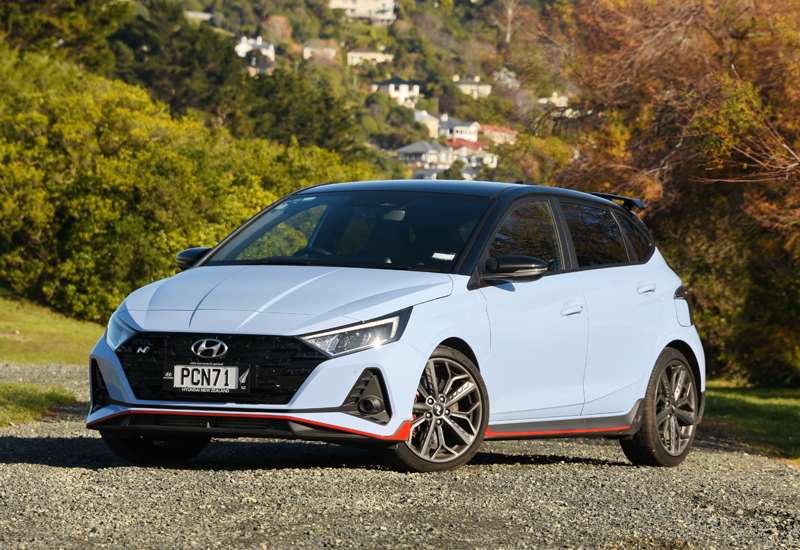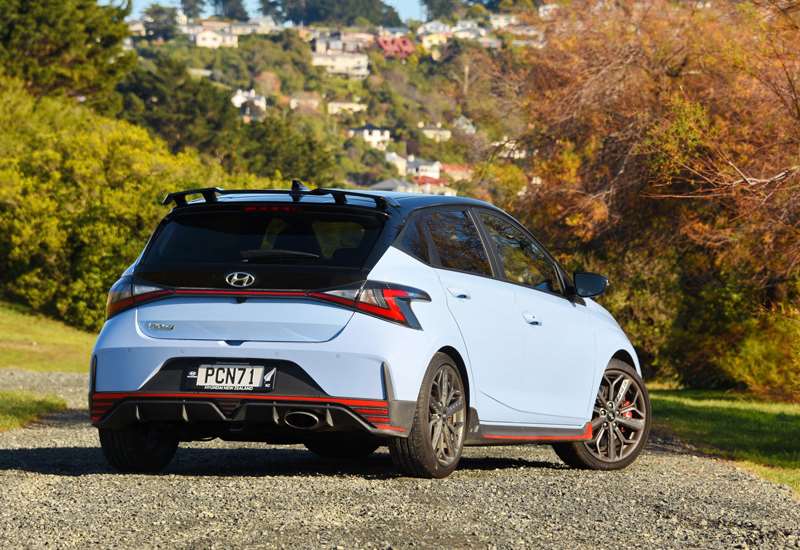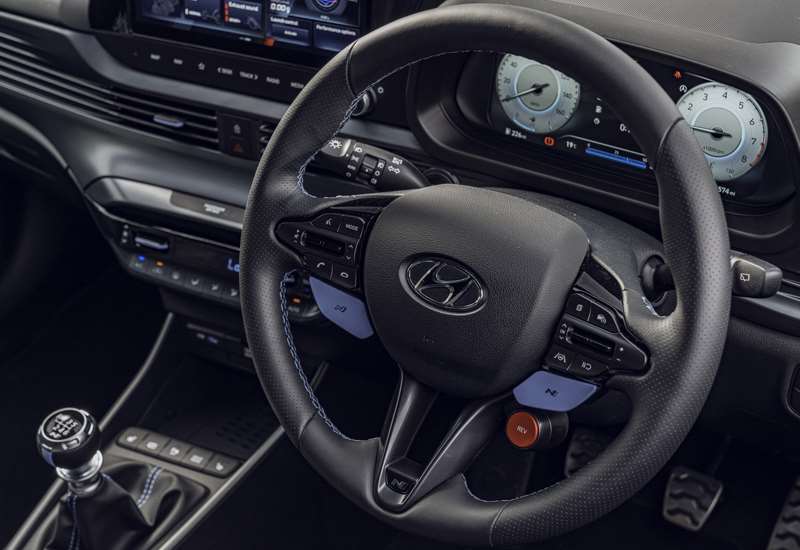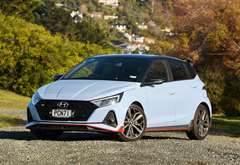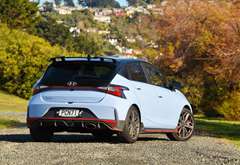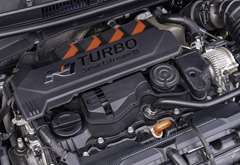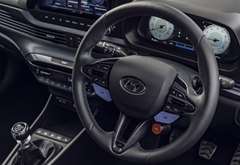While Hayden Paddon was getting to grips with his new Hyundai i20 WRC2 rally car in Europe a couple of weeks back, David Thomson slipped behind its road-going equivalent on local roads.
What’s new?
Until now, if you have wanted to bask in the reflected glory of Hyundai’s global rallying success in a road car, you’ve been plum out of luck.
Sure, a hot-hatch ‘‘N’’ version of the mid-sized i30 has been available since 2016, and a very good car it is too. But the smaller i20 has been Hyundai’s weapon of choice in rallying, powering the firm to 21 individual world rally championship wins, and back-to-back WRC manufacturers’ titles in 2020 and 2021.
A touch of that WRC magic is now available in road-going guise, with the appearance of the i20 N here.
‘‘Developed from Hyundai’s WRC success’’ is how the Korean marque references the link between the i20 N road car, and its rallying stablemate. Of course the front-drive road car is some way shy of the all-paw WRC machine in the performance stakes, but it has been developed in-house by Hyundai’s ‘‘N’’ motor sport division off the base point of a standard i20 hatch.
Power comes from a 1.6-litre engine equipped with a bespoke turbocharger and intercooler to deliver peak outputs of 150kW and 275Nm. Power delivery is to the front wheels, via two old-school performance car items — a mechanical limited slip differential and manual-shifting six-speed gearbox.
Structural changes from the standard i20 include chassis strengthening at key points, and reinforced suspension mounts. The suspension geometry has been altered, and high-performance shock absorbers and springs fitted. The brakes are massively uprated, and there are high-performance tyres, a particular version of Pirelli P-Zero rubber with compounds optimised especially for the i20 N.
Naturally there’s a sport-oriented cabin too, and a raft of exterior styling and aerodynamic enhancements.
In most markets the i20 N is the hero car for a wider i20 range, but here in New Zealand, it is for now the sole i20 variant offered. A $53,990 tag reflects serious intent as a performance car, but because it is frugal when driven gently, the i20 N manages to sit in the neutral zone for Clean Car fees and rebates. As an extra bonus, it will happily run on standard 91 Octane petrol.
What comes as standard?
Adaptive radar cruise control and head up display are the notable absentees from a safety specification that includes lane-keep and lane-following assist, blind spot monitoring and rear cross traffic alert, speed sign recognition, auto-dipping LED headlights, rain-sensing wiper and autonomous emergency braking with pedestrian detection.
The creature comfort and convenience list covers keyless entry and push button start, single-zone climate control, wireless phone charging, satellite navigation and a seven-speaker Bose sound system. There’s wired smartphone mirroring to the 10.25-inch centre display screen, which sits alongside a same-size fully digital main instrument cluster.
What’s it like to look at?
There are seven different colour options for the i20 N, but the overwhelming favourite will surely be the pale ‘‘performance blue’’ that featured on the test car. It’s Hyundai’s signature sports shade and it looks great in combination with the i20 N’s black pillars and roof, and the low-down red garnish line.
The body kit is designed for both visual and aerodynamic effect, and overlays nicely on the sharp crease lines that are part of Hyundai’s contemporary, angular design language. The ‘‘lip-stick’’ garnish line, ‘‘WRC-inspired’’ rear wing and red brake callipers peeping out from within the 18-inch alloys are the only truly flamboyant touches in what is otherwise an understated yet poised design. That said, there’s detailing to impress too, such as a front grille with patterning inspired by a chequered flag, and a race-car-style rear fog-light, centre-mounted on the diffuser.
If a standard i20 were available here to stand side-by-side, it would be apparent that the ‘‘N’’ sits 10mm lower too, purposefully poised on its 215/40 ZR18 tyres.
What’s it like inside?
If load- and passenger-carrying capacity are of importance, then the i20 N delivers well by compact hatchback standards: the boot manages a decent 310-litre luggage capacity when the rear seats are raised, expanding to 1123 litres when they are folded down. The rear seating position, meantime, is acceptable for two average-sized adults, with reasonable legroom and adequate head and shoulder space.
Trimmed with leather bolsters and fabric cushions, the front pews are comfortable and supportive, with decent lateral support.
Hard-touch plastics dominate the dash and doors, a reminder that the i20 N is based on an everyday mass-market small hatchback. Everything is well assembled (not in South Korea mind, as the i20 N comes off an Hyundai production line in Turkey), and the black lining above the waistline projects a classy look.
Three alloy pedals, the manual gear shift and a meaty sports steering wheel speak to the car’s sporting intent. So do the wheel-mounted ‘‘N’’ buttons; the one on the left is configured by default to scroll between the eco, normal and sport drive modes, and the one on the right to access the special ‘‘N’’ mode, which puts engine, exhaust and steering in their most aggressive settings. There is also a small red ‘‘rev match’’ button, to provide perfectly judged blipped throttle shifts when in sport mode.
Most hot hatch buyers will be more accomplished than me at navigating the various screen, drive and display options provided. There is a launch-control system for track-day fast-starts (along with five New Zealand track maps, track timing and the like), left-foot braking mode, torque and G-force displays and much more besides.
Customising of the displays for maximum sporting fun involves both the main instrument screen and the centre screen, which makes for a full-immersion experience simply getting set to run. Or you could just master a few basics, press the start button and get moving.
What’s it like to drive?
Even in its most civilised drive modes there is a sporty burble to the exhaust, completely natural when standing alongside the car and artificially enhanced when inside. Sport mode and beyond adds some measured crackle-and-pop too.
After months driving automatic or non-geared (electric) test cars, the simple manual co-ordination of gear lever, clutch and throttle gave an instant pleasure hit in town; the gearbox is a honey, with a smooth, precise shift action.
Especially in Eco or normal drive modes, the i20 N is an easy urban steer, though firm in the ride, and prone to tyre scrub when full steering lock is applied at very slow speeds.
The i20 N cruises happily enough on highways too, with ample accelerative vim for any occasion. There is some background mechanical noise at open road speeds (even in top, the engine is pulling 2500rpm at 100kmh), but once on coarse chip it is drowned out by an incessant road rumble that will surely prove wearisome on extended town-to-town trips.
To be fair, unless one is working to a luxury car budget, it is almost impossible to suppress coarse chip road noise when a car is running wide tyres designed to provide grip. And surefooted grip is, of course, a crucial part of the hot hatch equation. Dynamic poise and balance are also required to transcend the boundary zone between reasonably accomplished and truly engaging, and it is here that those responsible for the i20 N have excelled in mastering the hot hatch brief.
Engaging sport mode and guiding the test car down a sinuous stretch of back road tarmac, I was initially struck by how well it combines surefootedness with responsiveness. Twenty minutes later, I paused by the roadside to scribble a brief note, summarising how the component part of the i20 N dynamic package — engine and drivetrain, chassis and suspension, steering and brakes — combine harmoniously to deliver an experience that is greater than the sum of its parts.
Strong and willing once a hint of initial lag is overcome, the engine is especially this way from 3500, with its burble growing in intensity and being overlaid with a faint mechanical whine beyond 4000rpm. There’s not a lot to be gained from winding out beyond 5500rpm; better instead to take advantage of the slick gearshift — augmented by rev matching protocols that work especially well when driving in a press-on manner — to snatch another cog in the six-speed ’box.
This road test was conducted in the dry, but with portions of the test route overlaid with winter grit. Even so, the i20 N felt sure-footed throughout without the hint of nervousness that can afflict some quick cars in these conditions.
The brakes are excellent in all respects, and while the steering lacks a touch for feel (and is subject to some interference as the centre diff does its stuff), it is accurate and well-weighted. There’s ample seat-of-the pants feel too, conveyed by a chassis and suspension that allow the i20 N to corner flat and maintain fine body control.
Significant mid-corner bumps are certainly felt in the cabin, but they don’t tend to throw the car off its line. There is fine on throttle adjustability too, and the small size and relative lightness of the i20 N further add to its nimble character.
- David Thomson. Photos: David Thomson
